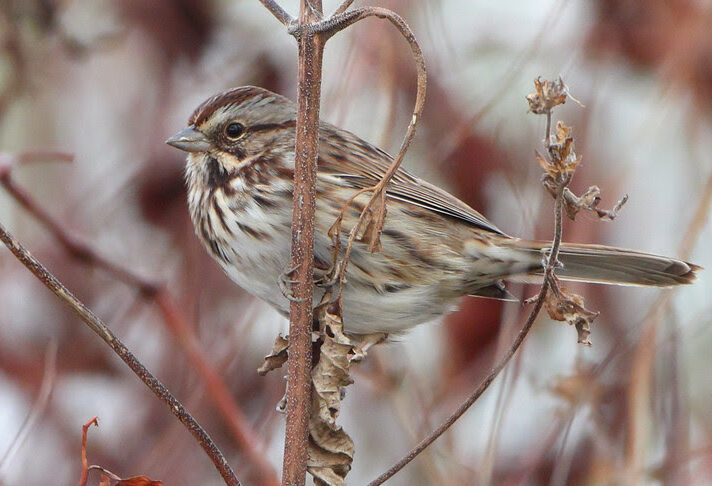Song Sparrow, Melospiza melodia
Bill Rowe
Sparrows don’t seem to get much respect—or at least they don’t elicit oohs and aahs of admiration as do the brightly-colored warblers, tanagers, and buntings. Yet their patterns are often intricate and handsome in a subdued way, like an oriental rug, and many of them have songs that are varied and distinctive. From all points of view, a good species to start with is the Song Sparrow, a common and familiar bird throughout most of Canada and the U.S. as either a nesting bird or a winter bird or both. Song Sparrows breed in dense vegetation near woods and wetlands, but also in urban and suburban areas wherever there is enough shrubbery to hide them and their nests. This means that there is probably a pair of them somewhere close to your house, no matter where you live. Using the link below, you should learn their jaunty song, hard to describe but easy to recognize, and then watch for them on a tree limb or the top of a bush. And if you put out feeders in the fall and winter, you should get at least an occasional Song Sparrow as a visitor.
IDENTIFICATION: Sparrows can be puzzling at first, and size and shape are often the best places to start in identifying the 18 species that occur in the St. Louis area. A Song Sparrow is on the large side (6+ inches), with a long, slightly rounded tail that it pumps as it flits from one shrub to the next. It is patterned in brown and gray above and has white underparts with bold, somewhat ragged brown streaks that usually coalesce into a spot at mid-breast (a mark that helps but does not separate it from several other streaked sparrows), plus heavy dark whisker marks at the sides of the white throat. Besides their song in spring and summer, they give a characteristic husky “chimp” call-note all through the year. As with nearly all sparrows, males and females look alike.
ST. LOUIS STATUS: A common summer resident, but even commoner in late fall, winter, and early spring, when we host an influx of Song Sparrows from farther north. Any area of weeds, shrubs, and dense grasses will have some.
Learn more and listen to the songs and calls of Song Sparrows here.




